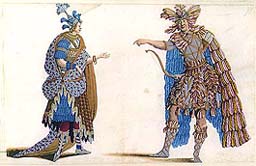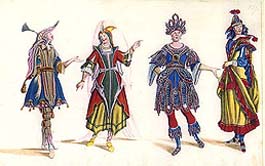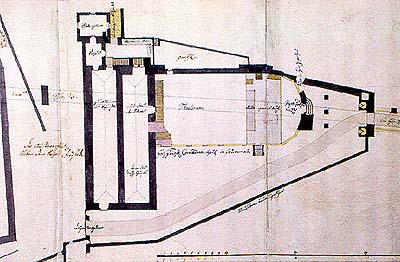Eggenberg Castle Theater in the 17th Century
 From the mid 17th century,
when the Krumlov dominion passed into the ownership of the Eggenberg
family, interest in world theatre among the castle society
increased - thus the first permanent theatre scene was built in the
so-called Deer Hall in 1675. The Salzburg architect Johann Martin
Schaumberger equipped it with a total of fifteen scene changes,
including four decorative halls (gold, red, blue, and stone), plus
a kitchen, a forest in summer, a forest in winter, a garden, rock
cliffs, an ocean, city, village, military camp, heaven, and hell.
The physical dimensions of this theatre evidently didn\'t suit the
demands of the royal owners, so in 1680 the great lover and
supporter of the arts Prince Johann
Christian I. von Eggenberg had a new independent theatre
building built on the Vth
Courtyard of Český Krumlov Castle. The theatre layout and
construction work was directed by the Italian builder Jakub
Maggi and Petr Spinetta, the decorations were again painted by
Johann Martin Schaumberger, while the carpentry work on the roof
and construction of the stage machinery were executed by
Laurentinus Khünmüller. At this time, a permanent musical ensemble
was active in the castle (see Eggenberg
Band) as well as a professional drama company (see Eggenberg
Actors). An extensive Eggenberg
Collection of Theatrical Items and Repertoire has been
preserved in the Castle
library in Český Krumlov.
From the mid 17th century,
when the Krumlov dominion passed into the ownership of the Eggenberg
family, interest in world theatre among the castle society
increased - thus the first permanent theatre scene was built in the
so-called Deer Hall in 1675. The Salzburg architect Johann Martin
Schaumberger equipped it with a total of fifteen scene changes,
including four decorative halls (gold, red, blue, and stone), plus
a kitchen, a forest in summer, a forest in winter, a garden, rock
cliffs, an ocean, city, village, military camp, heaven, and hell.
The physical dimensions of this theatre evidently didn\'t suit the
demands of the royal owners, so in 1680 the great lover and
supporter of the arts Prince Johann
Christian I. von Eggenberg had a new independent theatre
building built on the Vth
Courtyard of Český Krumlov Castle. The theatre layout and
construction work was directed by the Italian builder Jakub
Maggi and Petr Spinetta, the decorations were again painted by
Johann Martin Schaumberger, while the carpentry work on the roof
and construction of the stage machinery were executed by
Laurentinus Khünmüller. At this time, a permanent musical ensemble
was active in the castle (see Eggenberg
Band) as well as a professional drama company (see Eggenberg
Actors). An extensive Eggenberg
Collection of Theatrical Items and Repertoire has been
preserved in the Castle
library in Český Krumlov.
About the outfitting of the Eggenberg theatre we have no more preserved information. Even so, we can still get a rough idea of the layout and usage of space from two plans drawn up in 1760 as a basis for a proposal by the master Joseph Franz Fortini for the reconstruction of this theatre, as its condition was evidently quite bad by that time. From this plan, it appears that in the western part of the structure was the scene (Theatrum) with a relatively extensive stage area, expecially in comparison to the auditorium with parterre (Gemeines Auditorium) and royal box along the entire width of the rear part. Between the stage and auditorium was a rectangular area for the orchestra (die Music).

|

|
(om)


